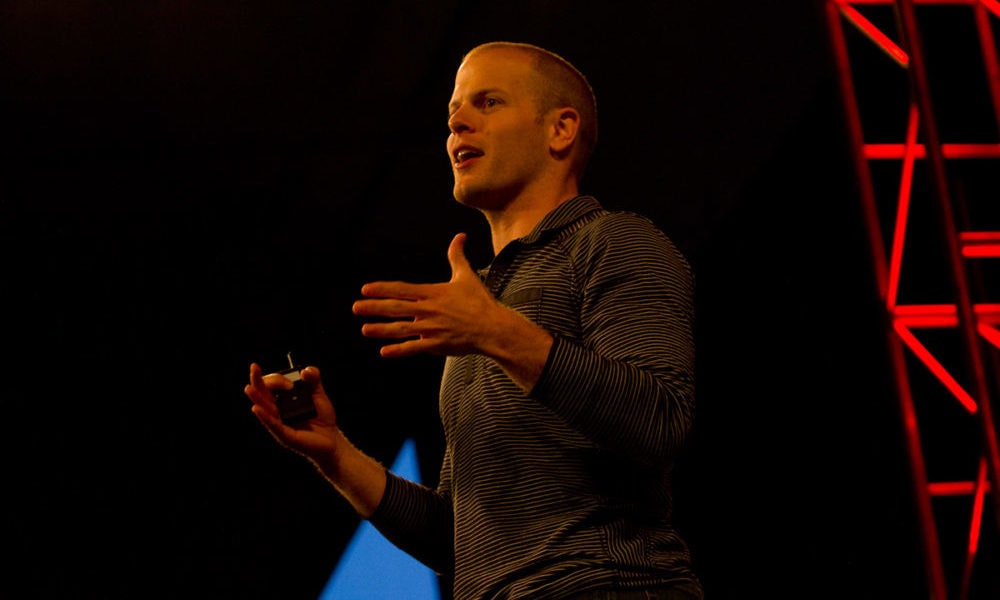
Between 2002 and 2004, Tim Ferriss was running a highly successful online business, making large sums of money and even having companies inquiring about buying him out.
There was only one, massive problem: he absolutely hated his life.
He was working 12 hours per day, never taking breaks, and constantly putting out fires. Stress dominated his life and he realized that his multi-million dollar business was leading him toward a nervous breakdown.
He knew something had to change.
And so he got out.
No, he didn’t sell his company. Rather, he developed systems and procedures and techniques that allowed him to get far more done in far less time. He learned various productivity secrets that allowed him to enjoy his life while still running a massively profitable business.
Elon Musk may work 100 hours per week, but Tim wanted to work no more than four.
Since then, Tim has continued to develop and refine these productivity techniques. To maximize his life in every possible way.
Since those chaotic days, he’s written the best-selling books The 4 Hour Workweek, The 4 Hour Chef, The 4 Hour Body, and most recently Tools of Titans. He hosts a podcast that gets hundreds of millions of downloads, runs a massively popular blog, and speaks at various events.
So here’s the question: how does Tim get so much done? How is he so productive?
Does he work insane hours? Is he a workaholic who can’t stop for a single second to breathe?
No. In fact, Tim believes in the “Lazy Manifesto” (a term coined by Tim Kreider). The idea behind the manifesto is making space in your life, margin for things are good and peaceful and restful. Rather than constantly grinding and hustling, taking time to simply immerse yourself in the things of life, whether that’s hiking or chilling in the library or enjoying a movie.
In his book We Learn Nothing, Kreider writes:
Idleness is not just a vacation, an indulgence, or a vice: It is as indispensable to the brain as Vitamin D is to the body, and deprived of it we suffer a mental affliction as disfiguring as rickets.
If this is Tim’s mentality as well, what is his secret to success? How does he accomplish so much in so little time?
Thankfully, we’re not left in the dark. Ferriss regularly shares his productivity secrets so that others can tap into them.
Here are some of Tim’s top methods for maximum output. He has shared these at different points on his blog, podcasts, and books. Unless otherwise noted, his quotes are taken from Tools of Titans.
Secret #1 – Create Rituals
Tim is really big on rituals, particularly in the morning. He believes that doing these rituals prepares him for the day and allow him to “win” the day. He has 5 rituals in particular that he seeks to do every morning.
Make His Bed
Making his bed does two things for Tim. First, it grounds him. It gives him something very simple to focus on and helps him remember that the little things in life actually do matter. Making his bed allows him to accomplish the first task of the day, which sets him up to accomplish other things that day.
He also does it because it allows him to maintain a sense of control. In Tools of Titans, he says:
No matter how s***** your day is, no matter how catastrophic it might become, you can make your bed. And that gives you the feeling, at least it gives me the feeling, even in a disastrous day, that I’ve held on to the cliff ledge by a fingernail and I haven’t fallen. There is at least one thing I’ve controlled, there is something that has maintained one hand on the driver’s wheel of life.
Meditate

Every morning, Tim practices some form of meditation or mindfulness. After interviewing hundreds of high achievers and noticing that 80% of them use this ritual, he realized that it was particularly powerful.
Do 5 to 10 Reps of Something
This is not intended to be a workout, but just to “prime” him for the day. He says it increases his mood and quiets the mental noise in his head.
Prepare Loose Leaf Tea
Tim drinks a variety of teas to improve his mental state and sharpen his thinking. Making tea prepares him for the final step of his morning rituals.
Journal
While sipping on his tea, he either writes in his “Morning Pages” or his 5-Minute Journal. He uses the morning pages to get unstuck on certain problems and uses the 5-Minute Journal to focus on gratitude.
Next Actions:
Rituals are a hugely productive way to create productive rhythms in your life. What rituals do you have in place every day? Consider creating a series of 3-5 short rituals that can prepare you to succeed. These rituals don’t have to be elaborate. Drink a cup of coffee. Exercise. Meditate. Anything that calms your mind, energizes your body, and puts you in a successful frame of mind.
Secret #2 – Focus On The 1-2 Most Important Things Every Day

In the outstanding book The One Thing, Gary Keller and Jay Papasan say the following:
[Achievers] have an eye for the essential. They pause just long enough to decide what matters and then allow what matters to drive their day. Achievers do sooner what others plan to do later and defer, perhaps indefinitely, what others do sooner. The difference isn’t in intent, but in right of way. Achievers always work from a clear sense of priority.
The most productive people know what is most important and focus on getting that thing done right away. In other words, they “eat the frog” (Brian Tracy’s term for doing the most important thing) every single day.
Tim Ferriss also does this. Every day he writes down 3-5 things that are making him anxious or uncomfortable. These are difficult tasks that are standing in his way. Then he asks himself:
If this were the only thing I accomplished today, would I be satisfied with my day? Will moving this forward make all the other to-dos unimportant or easier to knock off later?
This simple, single-minded focus allows Tim to make progress on his most important tasks every single day. Even if he gets nothing else done, he has worked on the thing that will generate the biggest ROI.
This kind of ruthless priority setting allows Tim to achieve more in less time. He says:
If I have 10 important things to do in a day, it’s 100% certain that nothing important will get done on that day. On the other hand, I can usually handle one must-do item and block out my lesser behaviors for 2-3 hours a day.
Next Actions:
Every morning (or the night before), create a list of your 3 most important to-dos. Identify the ONE thing on that list which will make the greatest impact. Block out 2-3 hours to work ONLY on that thing. If you don’t get to the other things, that’s okay. What matters is accomplishing the number one thing on your list.
Secret #3: Say, “No,” To A Lot Of Things

Success creates an odd catch-22. The more successful you are, the more opportunities you have. The more opportunities you take, the less time you have. The less time you have, the less you get done.
In other words, if you’re not careful, success can actually kill your productivity and keep you from getting anything done.
Tim writes:
Once you reach a decent level of professional success, lack of opportunity won’t kill you. It’s drowning in “kinda cool” opportunities that will sink the ship.
So what’s the cure? Tim says, “No,” to a lot of things and only gives himself to things he’s really passionate about. He doesn’t jump at every opportunity that comes along. He doesn’t see all opportunities as equally valuable. Rather, he only accepts those that he is 100% all-in on.
Tim follows the advice of Derek Sivers (creator of CD Baby):
Use this rule if you’re often over-committed or too scattered. If you’re not saying “HELL YEAH!” about something, say “no”. When deciding whether to do something, if you feel anything less than “Wow! That would be amazing! Absolutely! Hell yeah!” — then say “no.” When you say no to most things, you leave room in your life to really throw yourself completely into that rare thing that makes you say “HELL YEAH!” Every event you get invited to. Every request to start a new project. If you’re not saying “HELL YEAH!” about it, say “no.” We’re all busy. We’ve all taken on too much. Saying yes to less is the way out.
These days, FOMO (fear of missing out) is a big thing. Nobody wants to miss the next great opportunity. But if you constantly live this way, you’ll end up getting involved in lots of mediocre things and not have time to do the great things.
Next Actions:
Evaluate your current commitments and opportunities. Which of these commitments do you feel passionate about? Which do you only feel so-so about? Consider saying no to those opportunities that don’t thrill you and only saying yes to those you’re all in on.
Secret #4: Determine Your Handicapping Beliefs
Each of us have particular beliefs that handicap us. That hold us back from maximum output and joyful living. The longer we allow these beliefs to be present in our lives, the more they cost us.
Tim is a firm believer in identifying handicapping beliefs and then replacing them with a positive replacement belief (which he learned from Tony Robbins).
He writes:
One of my top 3 limiting beliefs was, “I’m not hardwired for happiness,” which I replaced with, “Happiness is my natural state.”…I used Scott Adams’s affirmation approach [repeating affirmations multiple times] in the mornings to reinforce it. Now, I’m well aware how cheesy this might sound on paper. Nonetheless, I experienced a huge phase shift in my life in the subsequent 3-4 weeks. Roughly a year later, I can say this: I’ve never felt consistently happier in my entire adult life.
The most productive, successful people refuse to let limiting beliefs hold them back. They take specific action to eliminate those negative beliefs and replace them with a positive narrative. This allows them to make massive progress in areas where they were previously stuck.
Next Actions:
Identify 3 beliefs you have that are currently holding you back. Beliefs that, if they don’t change, will have significant long term effects on your life. Now replace those negative beliefs with a positive narrative. Consider writing this narrative down and reviewing it multiple times per day. You’ll be amazed at how this reframes circumstances for you.
Conclusion
Tim’s productivity is not due to some secret, super-human strength. He simply has tapped into some specific productivity techniques that allow him to do more with less. He knows the power of rituals and sticks to them. He focuses on the things that matter most. He says no to a lot of unimportant things. And he minimizes his limiting beliefs.
You may not be Tim Ferriss, but you can certainly be as productive as him if you put these to work in your own life.

Nice article. It works great if you’re single with no kids and can control your day to day operations. A little less so if you don’t have the above going for you. For instance, my wife would get pretty ticked if I tried to make the bed with her in it. Writing peacefully in a journal is a messy affair with two kids asking Daddy about the wonders of the universe (like ‘why does the dog like to eat paper dad?’ Or ‘why can’t I grab the dogs tail dad?’).
I would enjoy seeing these ‘habits’ from the perspective of a successful father of multiple children (I have 4) who works for the government in a middle management position, been married for 20+ years and is in their mid 40’s or 50’s. Why don’t we get those kind of points of views? Have most people just given in to the drudgery by that age? Lol.
This article contains a nearly infinite number of great tips that will contribute to what we are all pursuing: joy. Thank you, Thanh.
Took the quiz but it would not take my email address so I could not get the results
Hi Mary, which quiz are you referring to? Can you send us the link?